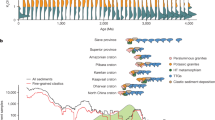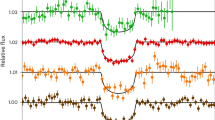Abstract
THE “orange soil” from Shorty Crater differs greatly from ordinary lunar soils in that it consists of ∼99% 10–300 µm smooth shiny spherules and broken fragments of spherules of transparent orange glass, about 20% of which contain partly crystallized to opaque material. The remaining 1 % is chiefly crystalline basalt fragments. Although the colour of the individual orange spherule varies with thickness from yellow–orange to red–brown, all orange glass in our sample (74220, 70; 0.25 g) has a uniform index of refraction (∼ 1.712). By contrast, other lunar soils contain spherules ranging from 1.50 to 1.75. The orange glass is also completely free of bubbles, to the limit of resolution of the light microscope, whereas bubbles are present in many other spherule samples. The spherules generally appear spherical in a normal microscope mount, but when viewed from two directions many are found to be oblate spheroids with axial ratios varying from near 1.00 to as low as 0.42 (Fig. 1a). Some have fissioned during free flight1 and all stages of the fission process are found, as described for the Apollo 11 samples. Only a few spherules seem to have been distorted by landing while still soft. One notable exception is the occurrence of small spherules of orange glass conforming and adhering to the surface of larger black spherules (Fig. 1b).
This is a preview of subscription content, access via your institution
Access options
Subscribe to this journal
Receive 51 print issues and online access
$199.00 per year
only $3.90 per issue
Buy this article
- Purchase on Springer Link
- Instant access to full article PDF
Prices may be subject to local taxes which are calculated during checkout
Similar content being viewed by others
References
Fulchignoni, M., Funicioello, R., Taddeucci, A., and Trigila, R., Proc. Second Lunar Sci. Conf., 1, 937 (MIT, Cambridge, 1971).
Chao, E. C. T., Boreman, J. A., Minkin, J. A., and James, O. B., J. geophys. Res., 75, 7456 (1970).
Ware, N. G., and Lovering, J. F., Science, N. Y., 167, 519 (1970).
Wood, J. A., Marvin, U. B., Powell, B. N., and Dickey, jun., J. S., Smithsonian Astrophysical Observatory Spec. Rep. 307 (1970).
Wood, J. A., et al., Smithsonian Astrophysical Observatory Spec. Rep. 333, 165 (1971).
Chamberlin, J. W., and Watkins, C., The Apollo 15 Lunar Samples (Lunar Science Institute, Houston, 1972).
Cross, C. A., Nature, 233, 185 (1971).
Kingery, W. D., Property Measurements at High Temperatures (Wiley, New York, 1959).
Roedder, E., Proc. IMA-IAGOD Meetings 1970, IMA Vol., Min. Soc. Japan Spec. Pap., 1, 5 (1971).
Short, N. M., Modern Geol., 1, 81 (1969).
Grant, R. W., Housley, R. M., and Paton, N. E., Lunar Science IV, 315 (Lunar Science Institute, Houston, 1972).
Agrell, S. O., Agrell, J. E., Arnold, A. R., and Bristol, C. C., Lunar Science IV, 12 (Lunar Science Institute, Houston, 1972).
McKay, D. S., Clanton, U. S., and Ladle, G. H., Lunar Science IV, 484 (Lunar Science Institute, Houston, 1972).
Roedder, E., and Weiblen, P. W., Proc. Apollo 11 Lunar Sci. Conf., 1, 833 (Pergamon, New York, 1970).
Brown, G. M., Holland, J. G., and Peckett, A., Nature, 242, 515 (1973).
Author information
Authors and Affiliations
Rights and permissions
About this article
Cite this article
ROEDDER, E., WEIBLEN, P. Apollo 17 “Orange Soil” and Meteorite Impact on Liquid Lava. Nature 244, 210–212 (1973). https://doi.org/10.1038/244210a0
Received:
Published:
Issue Date:
DOI: https://doi.org/10.1038/244210a0
Comments
By submitting a comment you agree to abide by our Terms and Community Guidelines. If you find something abusive or that does not comply with our terms or guidelines please flag it as inappropriate.



